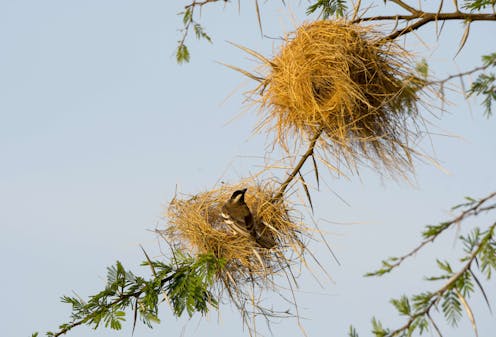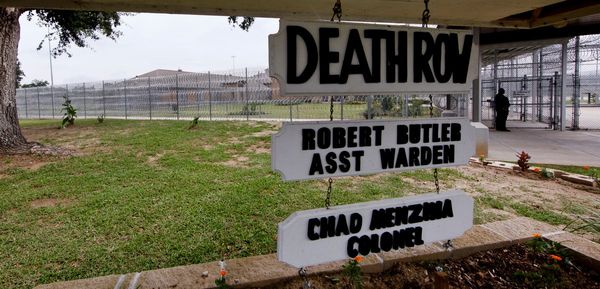
From afar, the acacia trees look like they have been decorated with grass pom-poms. The birds have been busy, building shelters of straw and grass. Up close the real shape of the “pom-poms” becomes clear: grass tubes in the form of an upside down “U”, with an opening at each end.
These structures are the work of white-browed sparrow weavers (Plocepasser mahali).
White-browed sparrow weavers are cooperative breeders. Within a multi-generational family group, only one dominant pair will reproduce; all other birds, which are mostly kin (related), will help with the rearing of chicks. These birds do everything together: forage, defend their territory, feed new chicks – and build each of the many roosts that decorate the acacia trees they live in. The birds are found throughout central and north-central southern Africa.
Year after year, family groups get bigger and, as they do, the number of roosts they build increases. Families might have as many as 14 individuals, so the birds need to build multiple roosts, including a few “spares”.
There’s something intriguing about these roosts. Sometimes different families set up territories next to each other, in trees as close together as 10 metres.
How do you tell families apart? By their roosts. Some families build roosts that are very long, with long entrance and exit tubes; others will build roosts that are much shorter, with hardly any tubes. Essentially, it looks like different white-browed sparrow weaver families have different architectural styles. Why?
To find out, we studied more than 400 roosts built by 43 families in the Tswalu Kalahari Reserve in South Africa’s Northern Cape province. We confirmed that the roosts and nests built by groups that live next to each other have their own architectural style, and that environmental, physical or genetic attributes of these different family groups do not influence the structures’ configuration.
We think that the birds’ building behaviour and the shape of the structures might be the result of social interactions. Animals often learn from each other how to do things, whether it is how to use tools (chimpanzees), how to sing the correct song (some bird species, humpback whales), or how to exploit new food resources (cockatoos). Learning from others within a group often results in animals showing group-specific behaviours, or animal cultures. In this sense animals, like humans, develop their own cultures.
Measuring various factors
There is a lot of diversity in the nests different bird species build, both in the shapes and the materials used, as well as the number of nests an individual might build.
For example, sociable weavers (Philetairus socius) build massive multiple occupant “apartment buildings” made out of grass. Cape penduline tits (Anthoscopus minutus) build nests that look like satchels made out of vegetable fibres with the texture of a wool sweater. Male southern mask weavers (Ploceus velatus) will weave thousands of grass leaves to build multiple nests at one time, and swallows collect and stack together one mud pellet at a time to build their pottery nests.
To better understand the lack of uniformity among different white-browed sparrow weaver families’ roosts, we measured 400 roosts, all still on the trees, built by 43 families in the Tswalu Kalahari Reserve. Some were new – less than a year old – and others were at least two years old. (All structures that we measured were also identified with a small ring. We did this for three years in a row, so we could tell if a structure was there before we started measuring and marking the structures or if it was built during our time there.)
Those measurements confirmed that different families build roosts with different sizes and that, across years, families maintain their own architectural style.
At the same time, we measured the temperature and wind speed at each of the families’ territories, the size of the birds, the height of the trees, how genetically related different families were to each other, and how far away the different families lived from each other.
This allowed us to determine whether any of these factors could explain why different families build different roosts. For instance, maybe families living in hotter territories build roosts with shorter tubes than in cooler areas, since they would not need much material to insulate them from the cold at night. The similarity in their environment, we reasoned, might explain why weaver families living in close proximity to each other created similar roosts. Or perhaps families that were more closely related to each other (something like cousins and second cousins) would build similar structures?
However, one by one, we excluded all environmental and genetic explanations for the differences in the structures built by different families.
So what happens next?
We plan to continue documenting the architectural styles of different white-browed sparrow weaver families and to record their building behaviour so we can determine how these birds coordinate their behaviour when building together.
Looking in more detail at how the roosts built by these birds across Africa might differ could help us understand to what extent the environment, material availability, individual experiences, and social interactions between individuals affect the building behaviour of these birds. Maybe, like humans, some species of birds have their own architectural traditions passed on across generations through social interactions.
Read more: Kalahari weaver birds lay bigger eggs when they have female helpers to feed nestlings
Biodiversity and its conservation are not only important in terms of the number of different species we need to protect – it also includes the unique behaviours that are transmitted across generations. Understanding how cultural traditions shape animal behaviour is also part of understanding the complexity of life.
Maria Cristina Tello Ramos received funding from the National Geographic Foundation and The Templeton World Charity Foundation.
This article was originally published on The Conversation. Read the original article.







